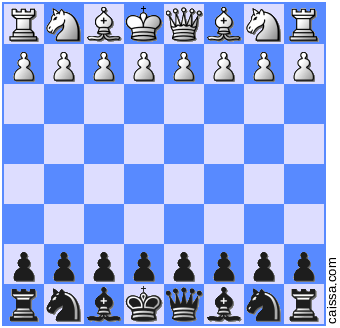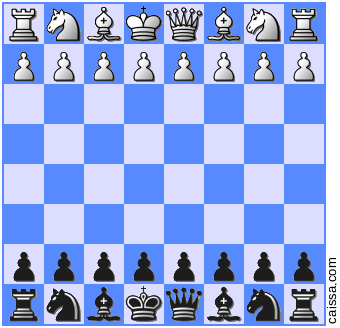Godzilla vs. King Kong...
Cowboys vs. Aliens...
Ninjas vs. Pirates...
Caveman vs. Astronaut...
The debates have raged on since the beginning of time.
I bring to you now... Scholars vs. Robots.
Okay... well it's really the Scholar's Mate Opening vs. the Robatsch Defense. And maybe it does technically transpose into a sort of Pirc. And it turns out it really isn't a fair fight. But the name is pretty damned catchy!
I'm sure most of you are familiar with Scholar's Mate. For those of you that aren't, white will open with e4 to bring out his bishop to c4 and his queen to either f3 or h5. Both pieces are aimed at black's weak f7 square (defended by just the king initially). If black doesn't play carefully, it's just a couple of moves for white to checkmate.
I was victim to a Scholar's Mate a few months ago when I first started playing. I kicked myself afterwards as I was familiar with it, but it was a good lesson in humility and paying attention. Now, it is a perfectly fair opening and a good teaching tool, but there's a lot of people out on the net playing this for a quick way to boost their ratings against newer players. They also tend to offer fairly hefty bets up front too.
I don't play by the rules, however...
If black plays smartly, he will be at a huge advantage. If you take note of the number of attackers vs. defenders for a square, and make developing moves that threaten him you should have no problem taking the battle to his front yard.
Game 1:
1. e4 g6
2. Bc4 Nf6 (the signal that he's trying a scholar's mate)
3. Nh3 Nxe4 (he's looking to bring the knight down to g5 for an extra attacker on f7... I munch on a pawn)
4. Qf3 Nd6 (he's not giving up on this... I can support the weak square with my knight)
5. Bd5 e6 (I guess he ran out of tricks... hey - free attack)
6. Bb3 Nc6 (he runs away and I develop - knights and pawns are excellent queen hunters this early on)
7. d3 Nd4 (I develop and push his queen)
8. Qe3 N6f5 (see above)
9. Qe5 Bg7 (same thing)
10. Qf4 Bh6 (he was gracious enough to skewer his queen and bishop)
11. Qe5 f6 (do you see a theme?)
12. He offered a draw.
13. I laughed.
14. He offered to reduce the bet.
15. I laughed more.
16. He disconnected.
Game 2:
1. e4 g6
2. Bc4 Nf6 (sigh... here we go again...)
3. Qf3 Nc6 (yep... I'll just develop and protect)
4. c3 Ne5 (guess he ran out of ideas... I'll just have to start the dance)
5. Qf4 Nxc4 (chow time)
6. b3 e5 (I'll trade you a knight for a queen)
7. Qf3 Nb6
8. Bb2 d5
9. h3 dxe4 (he's making it too easy)
10. Qe2 Nbd5 (getting into position)
11. c4 Nf4 (position gotten into)
12. Qf1 Nd3+ (hail to the king, baby!)
13. Ke2 Nxb2 (chow time, round 2)
14. f3 Nh5 (well... if you're gonna make me an outpost...)
15. Qe1 Qd3+ (queen check, double defended)
16. Kf2 Bc5+ (I'm getting disappointed that I might not get to castle here...)
17. Qe3 Bxe3+ (ahh... dessert!)
18. dxe3 Qd1 (like I care...)
19. g4 Nd3+
20. Kg2 Qe1 (mate is just around the corner)
21. He offered a draw.
22. I laughed.
23. He offered to reduce the bet.
24. I laughed more.
25. He disconnected.
Interesting how they play the same endgame, eh?
Guess they better go get their school money back!


No comments:
Post a Comment